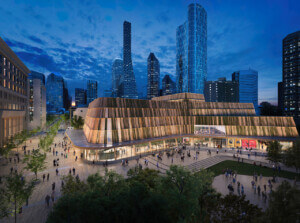Four winners and three student winners were selected to design art installations along Toronto’s beaches this winter. The concept behind the Winter Stations Design Competition is to enliven typically deserted beaches during the winter with whimsical structures.
This year’s theme, Freeze/Thaw reflected Ontario’s harsh climate and elicited playful responses with installations ranging from a fur-lined pod to a fragmented rainbow-hued cavern. The jury received nearly 400 entries from both local and international designers.
The seven winning designs will be built from February 10 to 14 along Kew, Scarborough, and Balmy Beaches. Installations will debut on February 15 and will stay open to the public through March 20.
“Visitors will discover a feast of textures in the schemes—from vessels clad in charred wood to sailing rope to vintage furs,” Lisa Rochon, senior fellow of Global Cities Institute University of Toronto and a jury chair said in a press release. “Inventive, playful and irreverent, all of the installations can be read like pieces of poetry on the beach. “
The winning designs are:
In the Belly of a Bear by Caitlind r.c Brown, Wayne Garrett and Lane Shordee
Three Calgary-based artists crafted this charred wood pod lined in thick, warm fur. Visitors are invited to climb in to get warm and enjoy the view from a round window.
Floating Ropes by MUDO
Described as a “rope forest,” Floating Ropes is a playful take on a permeable cube that visitors can crawl inside to reach a lifeguard chair with views of the lake.
Sauna by FFLO (Claire Fernley and James Fox)
Two U.K. landscape architects interpreted the “Thaw” theme literally with a tiered sauna. Transparent exterior walls allow glimpses of those within and solar powered lights illuminate it at night.
Flow by Team Secret (Calvin Fung and Victor Huynh)
Graduate students Fung and Huynh wanted to capture the “transitional moment between freeze and thaw.” They created digitally-fabricated 3-D stars through slot-fitting wood connections that can be easily reconfigured.
For the student entries, teams from three schools participated:
Lithoform by Remi Carreiro, Aris Peci, and Vincent Hui, Associate Professor, Ryerson University
This structure was inspired by frost in the Lithosphere, the outer layer of the earth. The team created a polychromatic cavern around a lifeguard station.
The Steam Canoe by OCADU. Toronto, Ontario
Project team: Curtis Ho, Jungyun Lee, Monifa Onca Charles, Reila Park, Hamid Shahi, Lambert St‐Cyr, Jaewon Kim, Jason Wong and Mark Tholen, Assistant Professor, Faculty of Environmental Design, OCADU
Evacuated solar tubes place at the rear of this “upside down” canoe are designed to melt snow into steam, which creates a halo of fog around the wooden structure.
Aurora Borealis by Chris Baziw, Ra’anaa Brown, Trevor D’Orazio, Andrew Harkness, Matthew Hunter, Danielle Kastelein, and Terrance Galvin, Director of Architecture, Laurentian University.
Surrounding a lifeguard station, this structure is created from fabric and LED lights on an aluminum and responds to body heat. When visitors touch the illuminated tubes, they change color.
“The public participation in Winter’s Station’s inaugural year proves that even the most overlooked winterscapes can be injected with vibrancy and life,” Ted Merrick, lead designer at landscape architecture firm Ferris + Associates said in the press release. “Our ultimate goal for year two remains the same—to encourage the community out of hibernation and back to the beach.”










